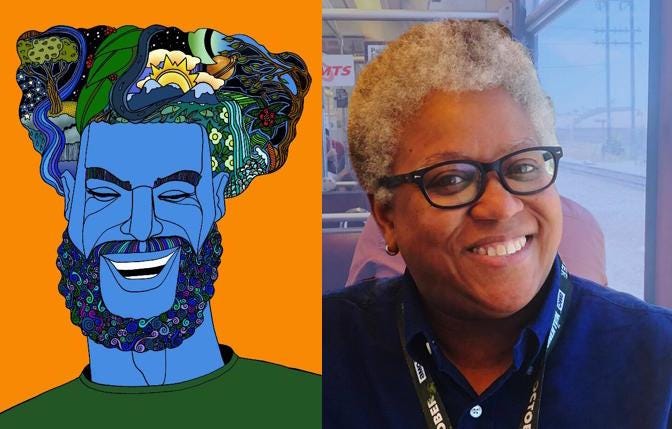The art of Ajuan Mance at the Cartoon Museum
"a celebration and exploration of what it is to be Black in the U.S."
San Francisco's Cartoon Art Museum presented the art of Ajuan Mance as part of its ongoing Emerging Artist Showcase. The exhibit also includes a collection of works including a celebration of Día de los Muertos, "Ghosts of the Apollo Theatre" from The New Yorker's Daily Shouts column, and interactive portraits enhanced by QR-code-enhanced animation.
Mance's illustrations and comics have appeared in several anthologies, including, most recently, "Drawing Power" from Abrams Press, winner of the 2020 Eisner Award for Best Anthology; "Menopause: A Comic Treatment," winner of the 2021 Eisner Award for Best Anthology; "She Votes" from Chronicle Books; "COVID Chronicles: A Comics Anthology," from Penn State University Press, and others.
Her work has also appeared in a number of digital and print media outlets, including the San Francisco Chronicle, Reed Magazine, Mission at Tenth, Publisher's Weekly, the New York Times, New Yorker, and Literature and Medicine.
A Professor of English at Mills College in Oakland, Mance has authored two fascinating books on African-American writers: "Inventing Black Women: African American Women's Poetry" and "Self-Representation, 1877-2000 and Before Harlem: An Anthology of African-American Literature from the Long Nineteenth Century."
Mance is perhaps best known for her series "1001 Black Men," and her unique style that explores the complexities of race, gender, and identity. As ever, the idea is to get past harmful stereotypes that impair our vision of others (and ourselves) to instead see —with eyes unclouded— the rich complexity of Black men as they exist in the world.
Mance confessed that it took her the first 300 drawings of Black men to recognize her own image bias in the types of men she chose to draw. She tended to draw men who reminded her of people she knew or dressed in a familiar way.
Importantly, she aims to bring to the fore the objectification of Black men that no one talks about. The hypersexual images of ads of the 1960s and '70s continue to color our view of Black men. To this end, Mance decided to attempt to depict virtually every type of Black man she encounters on the street and in daily life.
Mance's style is similar to graphic or pop art. The use of the heavy black line is almost ubiquitous within her portraits. She claims stained glass windows as her inspiration. She explained her creative inspirations in an interview with the Bay Area Reporter.
Laura Moreno: The stained-glass quality in your art evokes spirituality. Are you spiritual? What is your own spirituality? (To be human is to be divine?)
Ajuan Mance: My family has deep roots in the African American protestant tradition, and I feel a profound connection to the diverse ways that Black people around the world access and express reverence for things unseen. From the AME Church to Candomblé, Akom, Vodou, Santería, and beyond, the colors, language, and iconography of Black spiritual and religious traditions make their way into my work in so many ways. I am a part of the Black religious and spiritual tradition, and it feeds my creativity in so many important ways.
How have people responded to your work?
I have experienced so much love and support from the Black art community, from the Bay Area to Brooklyn. I draw strength and inspiration from my Black artist community, as well as from the heartfelt appreciation that Black viewers have shown for my work. My work is a celebration and exploration of what it is to be Black in the U.S., and it means a lot to me when Black viewers see themselves reflected in my art and comics.
I suppose the racism happens in our minds rather than on the page or in the actual images. Do you find Gwen Stephani's "Harijuku Girls" racist, for example? How can we all get on the same page on these issues?
If our minds were the only places where racism occurred, it would be a very different world. Racism definitely happens in actual images, on the page, on the screen, and in all forms of media. In my scholarly work as an English professor at Mills College, I study and write about literature that reflects how Black people see themselves and each other. I pursue a similar line of inquiry in my art. From my '1001 Black Men' portrait series to my comics and illustrations, I create art that reflects my experience of Black community and individuals.
You ask how we can get on the same page around issues of racism and cultural appropriation. I believe that the key step in addressing these concerns in a meaningful way is to center BIPOC voices and artworks. How do Black people, Indigenous people, and people of color depict themselves? On film, in music, on television, in books, and on museum walls, we need depictions of BIPOC individuals and communities that prioritize our experiences of the people and places that shape our lives.
Who are some of your favorite artists? Cartoonists?
Many of my favorite visual artists do figurative work. For example, I love the work Kara Walker, Elizabeth Catlett, Mickalene Thomas, Kerry James Marshall, and Kehinde Wiley, and George Grosz.
It's much harder to come up with a list of favorite comic creators. There are so many amazing and talented people working in this medium. I really enjoy the work of Gilbert and Jaime Hernandez, Thi Bui, Ebony Flowers, Kat Leyh, MariNaomi, and so many others! Sometimes if feels to me that we're the midst of a comics renaissance!
The Cartoon Art Museum's Emerging Artist Showcase www.cartoonart.org




